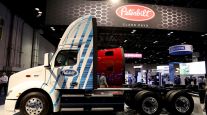Paccar’s 1Q Profits, Revenue Soar as Worldwide Demand for Trucks Increases
This story appears in the April 25 print edition of Transport Topics.
First-quarter net income and revenue soared for Paccar Inc. as the original equipment manufacturer benefited from increased global demand for its products, including Kenworth and Peterbilt trucks in North America.
A 47.2% increase in revenue led to a 183% gain in profits, the company said in its April 19 quarterly statement.
Paccar earned $193.3 million, or 53 cents a share, on revenue of $3.28 billion from January through March. During the same time in 2010, the company earned $68.3 million, or 19 cents, on revenue of $2.23 billion.
The consensus estimate for quarterly earnings was 49 cents a share, Reuters reported.
“Class 8 industry retail sales in the U.S. and Canada in 2011 are improving steadily. There are industry concerns about suppliers being able to increase their production capacity to meet global demand,” Executive Vice President Dan Sobic said in the statement.
First-quarter results were good enough that Paccar increased its industrywide, heavy-duty North American sales forecast to between 200,000 and 220,000 trucks for this year. On Feb. 1, the company’s estimate was 180,000 to 200,000 units.
Paccar said its North American revenue rose 38% from the 2010 quarter, European business grew by 53.5% and the rest of the world by 65.8%.
The company said it projects worldwide capital expenditures of $400 million to $500 million this year, and research and development expenses of $275 million to $300 million.
In a question-and-answer exchange with stock analysts, Chairman and CEO Mark Pigott said 25% of the Kenworths and Peterbilts now being built are powered by Paccar’s new MX engine, meaning that 75% of the engines are supplied by Cummins Inc. Pigott said his engine plant in Columbus, Miss., is making 25 engines a day and that he imports another 25 engines a day from Paccar’s Dutch subsidiary DAF Trucks.
Pigott also said the company will keep the current customer menu of the 12.9-liter MX and the ISX 15-liter from Cummins. He denied that Paccar is developing its own 15-liter engine.
Pigott offered a similar argument often made by competitor Navistar Inc. that even North American trucking is moving from a 15-liter standard for engines to 13-liter power plants with greater density in terms of horsepower per liter of displacement.
“The rest of the world has 13 liters as the highest and largest engines that they use. I would say over time that there’s already a shift happening in North America, that 13 liters will be a larger and larger component of the engines being purchased, along with 11 liters and 9 liters, things like that,” Pigott said.
“There’s no particular reason why North America should be the only market in the world with such a unique powertrain being demanded by our customers,” he added.
Pigott also spoke about rising commodity prices as an issue for OEMs.
“I mentioned rubber up 200% [since 2009], but you look at carbon for steel and copper and stainless steel, palladium going into the engine, I mean, a lot of these are up 60%, 80% over the last two years. Now some of that is small dollars and some of it’s large dollars, but there’s a real demand driving some of that higher prices, and we have to pay them as our competitors do,” Pigott said.
“We try to pass some of that through, but as we talked about a few months ago, particularly on the exhaust side, it’s very difficult to get all that pass-through to the customers. Maybe a little bit better now than it was three months ago. So we continue to look at it every single day, and we’re able to adjust our pricing. We do, but sometimes it’s just something we have to absorb in the cost of sales,” he said.
Stockholders’ equity, or corporate net worth, rose to $5.65 billion on March 31 from $5.36 billion on Dec. 31.



